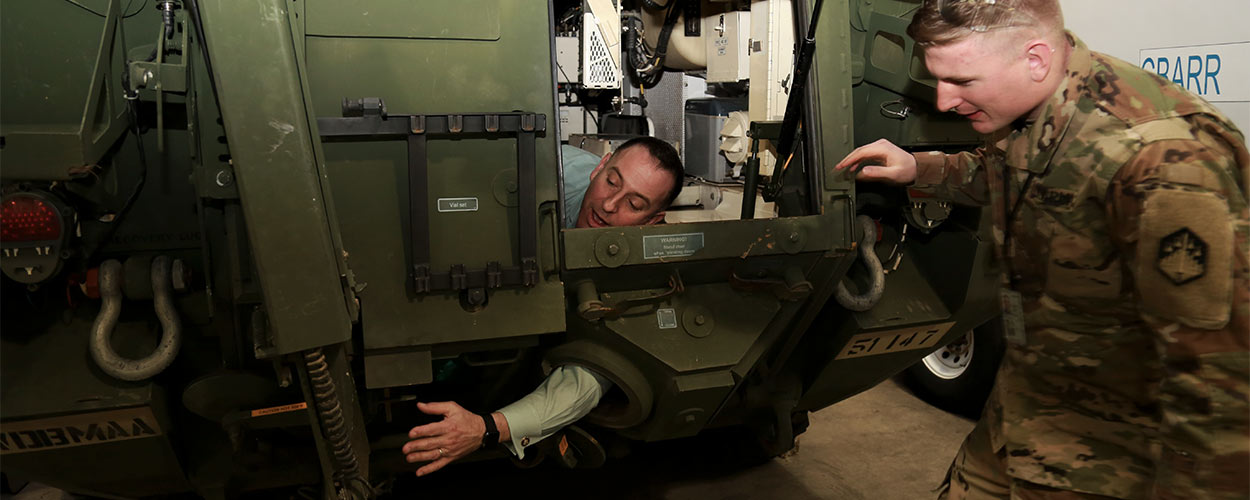Army Lab Brings Soldiers and Scientists Together to Operationalize Science
Army Lab Brings Soldiers and Scientists Together to Operationalize Science
By Shawn Nesaw
In the Army, everyone has a job to do. In the simplest of terms Soldiers fight and scientists experiment, but both work towards the same goals, serve their countrymen and accomplish the mission.
Soldiers and scientists fight on different fronts. Scientists “fight” in the laboratories, developing new materials, protective capabilities and decontamination capabilities that support the Soldier on the battlefield. Soldiers fight on the battlefield, and are tasked to close with and defeat the enemy in ground combat. Soldiers utilize the myriad of capabilities scientists and engineers develop to carry out their missions.
In the past, the Soldiers and the scientists have had limited contact with each other, each operating in their respective lanes. Scientists build and shepherd the capability through the lengthy acquisition process. If the capability is destined for the field, select Soldiers will get hands-on time to help determine what works and doesn’t. Soldier feedback may not be incorporated into the current iteration of the product, but a future version.
As Army leaders looked towards the future of the battlefield and the pace of innovation, they saw opportunities to improve how things are done. As Army Futures Command was forged in early 2019, it was clear the Army had big modernization goals in mind and in order to accomplish these goals quickly and efficiently, leaders across the Department of Defense pushed for changes.
Leaders at the U.S. Army Combat Capabilities Development Command (CCDC) Chemical Biological Center saw their own opportunities to enact change as well – opportunities to influence the future for how they do business, how they develop products and how they support the Soldier.
“We could see the direction Army was headed and we felt it was important to get out ahead of it,” said Eric Moore, Ph.D., CCDC Chemical Biological Center director. “Through some informal meetings with the 20th CBRNE Command, we developed the initial plans for bringing Soldiers from the 20th to the Center to meet with our researchers on a regimented basis.”
The idea was to bring Soldiers and scientists together to collaborate on modernizing existing technology, develop new technology and forge stronger relationships to benefit both groups.“In my past experience, scientists and engineers work on their own and had few if any opportunities to interface with Soldiers,” said Peter Emanuel, Ph.D., who works at the Center as the Army’s senior research scientist for bioengineering.
“Making Soldier-scientist interactions a priority is paramount for the future of the Army,” Emanuel continued. “Engineers and scientists are professional problem solvers so if we’re going to solve problems, they better be the Soldier’s problems.”
The CCDC Chemical Biological Center operates five programs aimed at interfacing with Soldiers and solving the challenges they face on the battlefield.
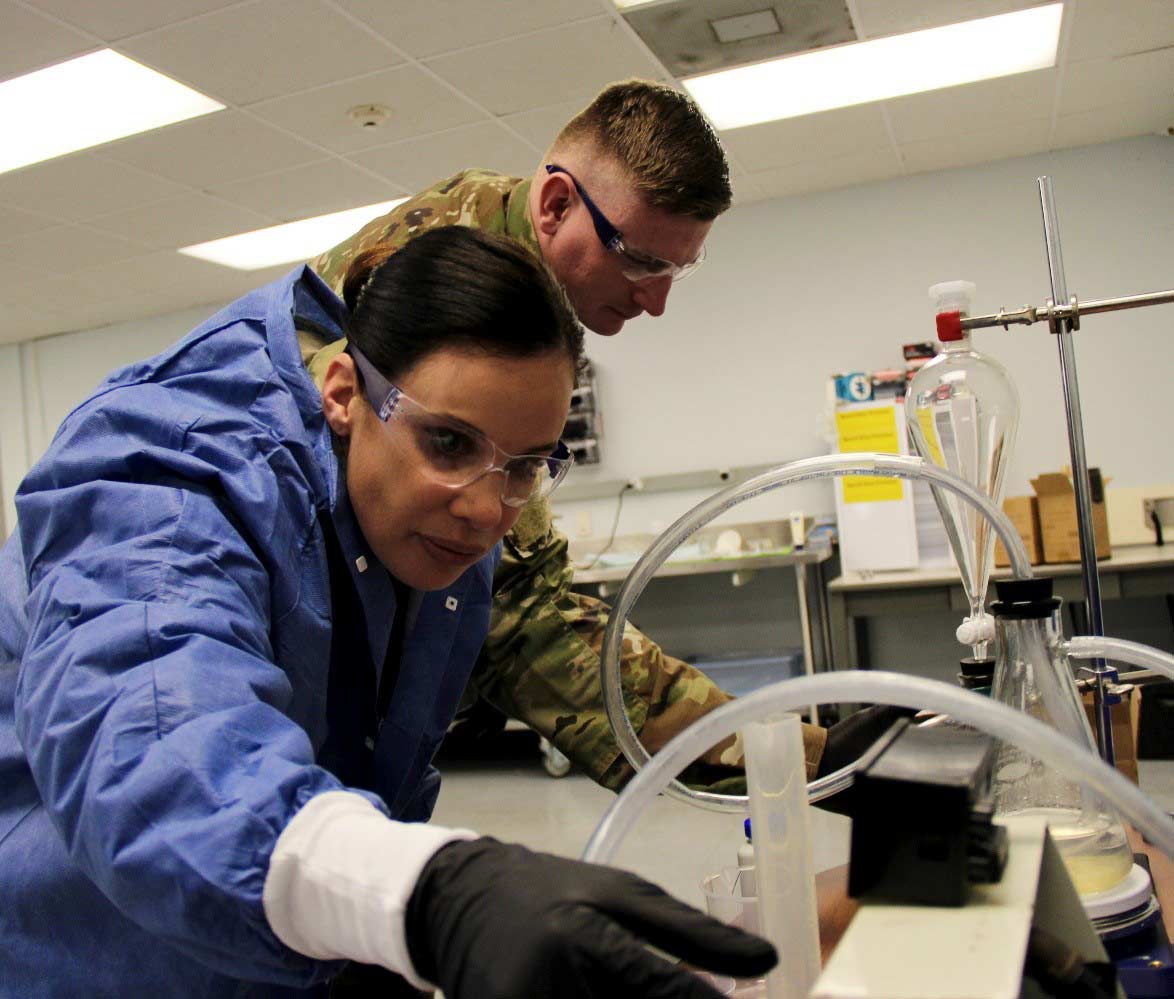
Photo by Shawn Nesaw.
CBRNE Warrior Integration Program
The CBRNE Warrior Integration Program (CWIP) brings Soldiers and scientists together in a collaborative working environment. The program, developed and implemented by the CCDC Chemical Biological Center, provides 20th Chemical, Biological, Radiological, Nuclear and Explosive (CBRNE) Command Soldiers opportunities to learn and grow as CBRNE noncommissioned officers while assisting the Army by working in partnership with science and technology teams developing emerging technologies for future capabilities.
Soldiers come to the Center on a 35-40 day duty assignment, meeting with scientists in a variety of situations that provide opportunities for open discussions about the roles each play.
Scientists gain a deeper understanding of what Soldiers encounter in training and on the battle field and Soldiers gain a knowledge about what scientists do to support the mission and provide feedback on new technology. Participants in the pilot program provide weekly feedback to 20th CBRNE Command leadership in order to shape future iterations of the program.
Sgt. Ryan Ashley, a CWIP participant, found his one-month experience at the Center beneficial.
“It’s a really rare opportunity to come from a line unit and be involved so directly with those developing future kit,” he said.
After an initial brief to the Center’s workforce, Ashley was immediately approached by researchers eager to ask questions of the young warfighter.
“I took every opportunity to talk with scientists and engineers about their work and give them my honest input based on my knowledge of how the Army and my unit operates,” Ashley said. “The discussions were vital in making a difference for the future.”
Emanuel wasted no time meeting with Ashley once he heard about how Ashely’s unit performed sampling from a Nuclear Biological Chemical Reconnaissance Vehicle (NBCRV).
“I was frankly shocked to learn how the sampling was done,” Emanuel explained. “So much so I had to get inside the recon vehicle with Sgt. Ashley to experience it for myself. It was extremely difficult to say the least.”
Emanuel took his new understanding and found that, fortunately, solutions to some of the shortfalls of the NBCRV sampling tools were already being addressed.
The experience is an example of just how critical a constant flow of Soldier input is to researchers. “CWIP is bringing the Soldiers right to us at the Center, every scientist should take full advantage of these opportunities, because they are unique and we are fortunate that our leadership places such high value on these interactions,” Emanuel said.
“CWIP is good for the unit, the Soldier and the scientist.” Ashley said. “I brought back valuable information to my unit and, vise-versa, provided valuable feedback that scientists can use to improve their design and development processes.”
While Ashley has moved on, the connections he made during CWIP were important, “I have direct access to the team developing the sensor suite package for the NBCRV, a vehicle I’m intimately involved with in my unit, which allows me to provide support to that team whenever they need it.”
In addition to CWIP, Center Chief of Staff Thomas Woloszyn integrated the Warfighter Lecture Series which provides opportunities for researchers to hear from Army-wide senior leadership, ensuring scientists are hearing from all levels of the Army.
CBRN Warrant Master Trainer Program
Similar to CWIP is the CBRN Warrant Officer Master Trainer Program, which invites warrant officers to embed themselves with the Center workforce to enhance their skills on a variety of CBRN procedures in order to train their counterparts. CW2 Meredith Reed took part in the program, meeting with subject matter experts (SMEs), specifically the Advanced CBRNE Training Team, to advance her chemistry and biology knowledge base.
“The training I received at the Center was extremely valuable,” Reed explained. “During training exercise development, I was able to reach back to my contacts at the Center to ensure my training was thorough and realistic.”
During her time at the Center she also learned processes and procedures scientists and engineers go through during the research and development of new CBRNE technologies. Reed had the opportunity to interface with the SMEs who develop detection, filtration and decontamination capabilities for the CBRN Soldiers. Scientists and engineers had first hand access to Reed who gave valuable feedback regarding capabilities currently in development at the Center.
“Providing Soldier input at the user level on equipment we use every day helps scientists tailor capabilities to what we actually need and what is feasible in the environments we work in,” Reed said.
Warfighter Innovation Leveraging Mission Expertise and Experimentation Program
Another such program is the Warfighter Innovation mission Leveraging Expertise and Experimentation Program (WILE-E). This Center-led initiative employing design thinking methodologies brings a multidisciplinary team of Center scientists, engineers, technicians, analysts and logisticians together to solve Soldiers’ real-world operational challenges.
“We’re absolutely convinced that the best people to develop next-generation chemical and biological decontamination and detection capabilities for the future Soldier are the scientists and engineers here at the Center,” said Megan Hower, chief of the Acquisition Program Management & Matrix Support Division.
WILE-E breaks the mold in terms of the typical way of developing capabilities where Soldiers input is left until the end of the process. For the entirety of the six-month project, WILE-E scientists gather Soldier input throughout the project. By incorporating the end-user throughout the process, the team is more likely to develop a capability the Soldier actually needs. It also means less trips to the drawing board for large revisions to design and use because Soldiers will dictate the decisions upfront.
The new team has their sights set on creating solutions by harvesting the collective genius of the Center.
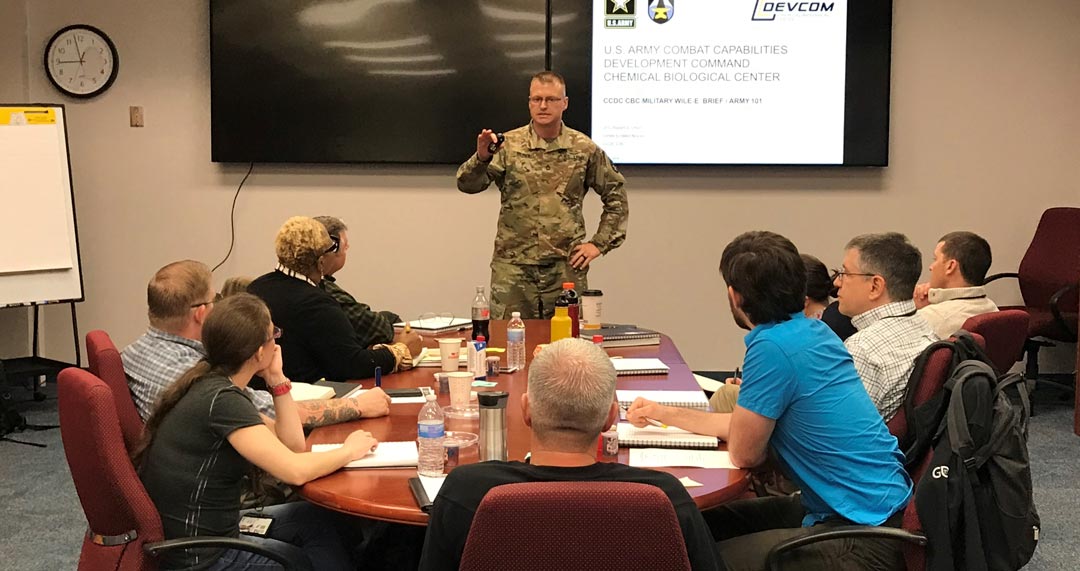
Photo provided by CCDC Chemical Biological Center.
The WILE-E group has direct access to CWIP Soldiers, U.S. Army CBRN School subject matter experts (SME) and senior leaders, and CCDC Chemical Biological Center SME’s among others, all to help fill knowledge gaps of the end users and their needs and goals.
From a new Army 101 course offered by Center NCO SFC Robert Olson, which gives scientists a crash course on life as an infantryman, to deep-dive discussions with CBRN Chemical School Deputy Commandant Scott Kimmel on topics such as CBRN Operations Force Modernization Strategy, Center scientists participating in WILE-E are getting Soldier input from all angles, all the time.
Through programs like WILE-E and CWIP, scientists gain insight from Soldiers experiences which allows them to hone their development process to provide the warfighter capabilities they can really put to use. At the same time, through these programs, Soldiers learn what the development process looks like from the lab side and gain a better understanding of the scientists’ processes and perspectives.
Scientists who are eager to gain an even deeper understanding of the challenges faced by Soldiers can enroll in the Greening Program and Scientist in a Foxhole.
Greening Program
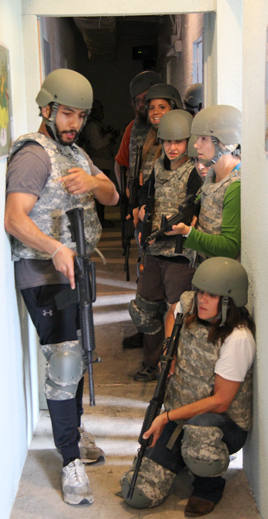
Photo provided by Aberdeen Proving Ground.
An immersive, seven-day program, the Greening Program is designed to give Army civilians a taste of what a Soldier’s life is like. From Army basics such as marching and Army values to more advanced warrior skills such as urban combat tactics and marksmanship, civilians get to feel what it’s like to be a Soldier.
Elizabeth Groover specializes in organizational development and training for the G1 at the Center. She participated in the 2018 Greening Program and came away from the experience with a whole new view of what it means to be a Soldier.
“The Greening Program really helped me understand how a Soldier thinks and acts,” Groover said. “My husband is active duty so I thought I knew a lot about Soldier life, but I was mistaken. The Greening Program gave me an even deeper appreciation for every man and woman who dedicates their life to the service and protection of this country. I use that knowledge in my current role when assessing and presenting to teams at the Center to this day.”
Scientist in a Foxhole
Similarly, Greg Peterson, a research chemical engineer, took part in Scientist in a Foxhole, a CBRN focused immersive experience for researchers where they team up with Soldiers to gain a better understanding of the end-users needs, the environmental demands and user demands.
“It was very specific to our problems and issues with chemical and biological capability development. We were able to speak directly to the personnel using the equipment that we develop,” Peterson said.
At the most recent Scientist in a Foxhole event, CCDC Chemical Biological Center scientists observed the 48th Chemical Brigade during field training and exercises at Dugway Proving Ground, which evaluated how tactical teams would assess suspected CBRN threats found in clandestine and large scale laboratories, and how samples from these labs could be collected and analyzed.
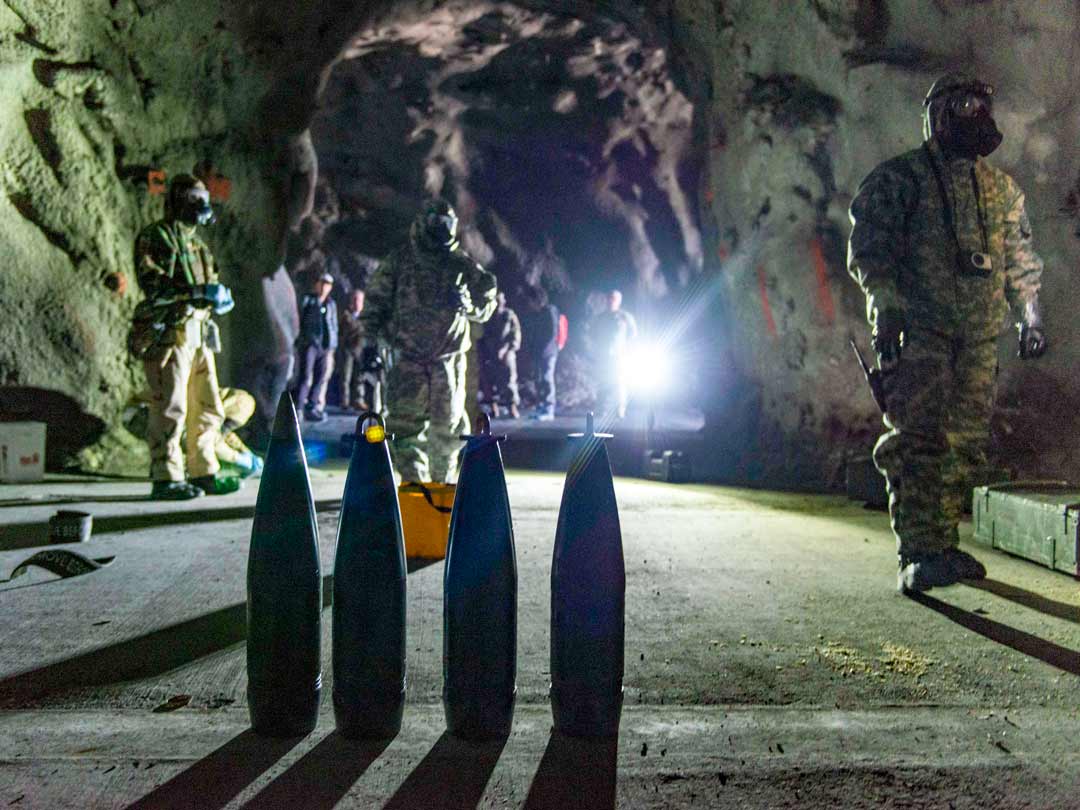
Photo provided by Dugway Proving Ground.
Center chemist Neil Hawbaker, Ph.D., attended the event to gain perspective of the end-user for technology and techniques he is developing currently and for ones in the future.
“It’s important we develop technology and techniques with the end user in mind,” Hawbaker said. “In doing so, it’s more likely Soldiers will use the technology correctly and frequently and techniques will be performed correctly.”
Opportunities to sit down with the Soldiers for discussions about various CBRNE topics proved beneficial to all involved.
“We got a chance to also understand more of what goes into operations on the ground and where areas for improvements were,” Hawbaker explained. “One Soldier described how it was hard to tell if the decontamination solution completely covered the Soldier during decon. This comment highlighted an area of need we need to consider in the future of tactical decon process.”
Another key takeaway from the event was considering maintenance, upkeep and shelf life when developing technology. Additionally, improvements in training on technology and techniques was something Soldiers highlighted as a critical need because some technologies are underutilized.
“We’re so focused on effectiveness that we sometimes overlook the practicality of the technology until later in the development process. When you see someone in full MOPP 4 and covered in detectors and sensors, you start thinking about more practical elements of any tech and how the end user will function,” Hawbaker said.
Committed to Collaboration
As the only noncommissioned officer permanently assigned to the Center, Olson noted that the Center’s efforts to bring Soldiers and scientists together send a strong signal to Soldiers and the Army’s research community.
“These five efforts embraced by the Center represent a strong and deliberate push towards better collaboration among not only scientists and engineers but also Soldiers and the research and development community,” Olson said.
Emanuel agreed, adding that the Army’s goal of modernization goals can only be achieved through collaboration.
“Never in the Center’s history have this many collaborative efforts been taking place to ensure knowledge sharing among the warfighter and the scientist occurs,” Emanuel said. “It’s collaborative efforts like these, bringing Soldiers and scientists together, that will truly move the needle for the Army, ensuring rapid modernization occurs on the home front which can be applied for decisive overmatch on the battlefront.”
Peter Emanuel, Ph.D., reaches for the exterior sampling arm from inside an NBCRV, experiencing, first hand, the challenges Soldiers like Sgt. Ryan Ashley must manage during training and deployment.
Photo by Shawn Nesaw.

